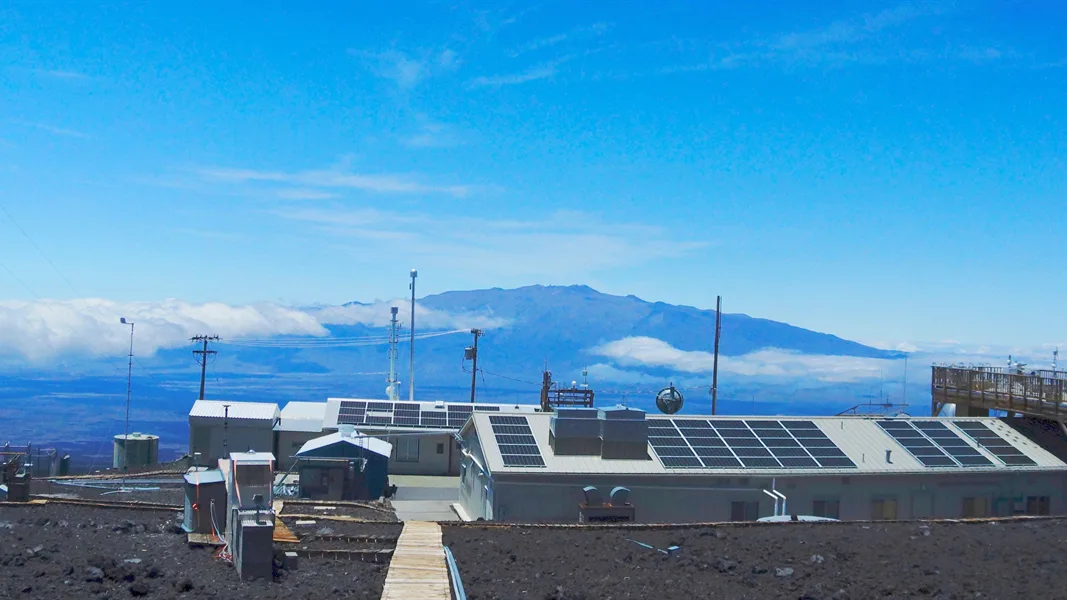
CO2 at Mauna Loa exceeds 420 ppm for the first time in human history
Despite lockdowns, carbon dioxide levels in the atmosphere are still rising fast, and are now higher than they've been in over 3.6 million years.
Carbon dioxide levels measured in one of the most remote places in the world have reached a new peak, setting a record for the highest level measured in human history.
Originally published on May 18, 2021, this story has been updated.
On April 30, 2021, instruments at NOAA's Mauna Loa Observatory in Hawai'i recorded hour-by-hour measurements of carbon dioxide (CO2) in excess of 420 parts per million — the longest stretch of measurements above this threshold to date. At end-of-day, the site tabulated these records and logged an official daily average value for carbon dioxide of 420.29 parts per million (ppm).
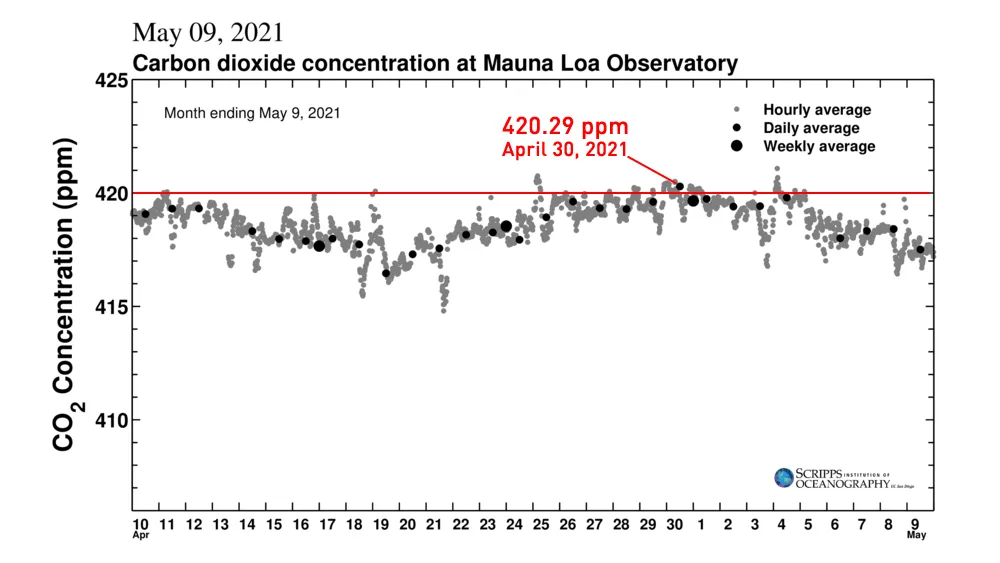
The 'monthly ending May 9' graph of the Keeling Curve shows the daily average carbon dioxide value on April 30 exceeded 420 parts per million (ppm). Grey dots indicate hourly records, small black dots are the daily averages computed from those records, and larger black dots are weekly averages. Red line at 420 ppm and text noting April 30 peak added by author. Credit: Scripps Institution of Oceanography/Scott Sutherland
This value is the highest recorded carbon dioxide concentration measured at Mauna Loa this year and the highest seen at the site since it was established in 1958 (when CO2 was at around 315 ppm). Based on extensive research into carbon dioxide levels throughout the planet's geological history, this is also the highest CO2 concentration Earth has seen in millions of years.
In an official update on June 7, NOAA provided a tally of the latest monthly average CO2 concentration at Mauna Loa Observatory.
"In May, NOAA's measurements at the mountaintop observatory averaged 419.13 ppm. Scientists at Scripps calculated a monthly average of 418.92 ppm. The average in May 2020 was 417 ppm," they wrote.
"We are adding roughly 40 billion metric tons of CO2 pollution to the atmosphere per year," Pieter Tans, a senior scientist with NOAA's Global Monitoring Laboratory, said in the update. "That is a mountain of carbon that we dig up out of the Earth, burn, and release into the atmosphere as CO2 — year after year. If we want to avoid catastrophic climate change, the highest priority must be to reduce CO2 pollution to zero at the earliest possible date."
HIGHEST IN HUMAN HISTORY
Based on the yearly cycle of carbon dioxide, this May 2021 value serves as the maximum monthly value for the year. It is also the highest value of CO2 ever seen, either in the current instrument record, or by measurements of gases taken from ice cores, going back hundreds of thousands, to millions of years.
According to NOAA, "The atmospheric burden of CO2 is now comparable to where it was during the Mid-Pliocene Warm Period around 3.6 million years ago, when concentrations of carbon dioxide ranged from about 380 to 450 parts per million. During that time sea level was about 78 feet higher [24 m] than today, the average temperature was 7 degrees Fahrenheit [3.8°C] higher than in pre-industrial times, and studies indicate large forests occupied areas of the Arctic that are now tundra."
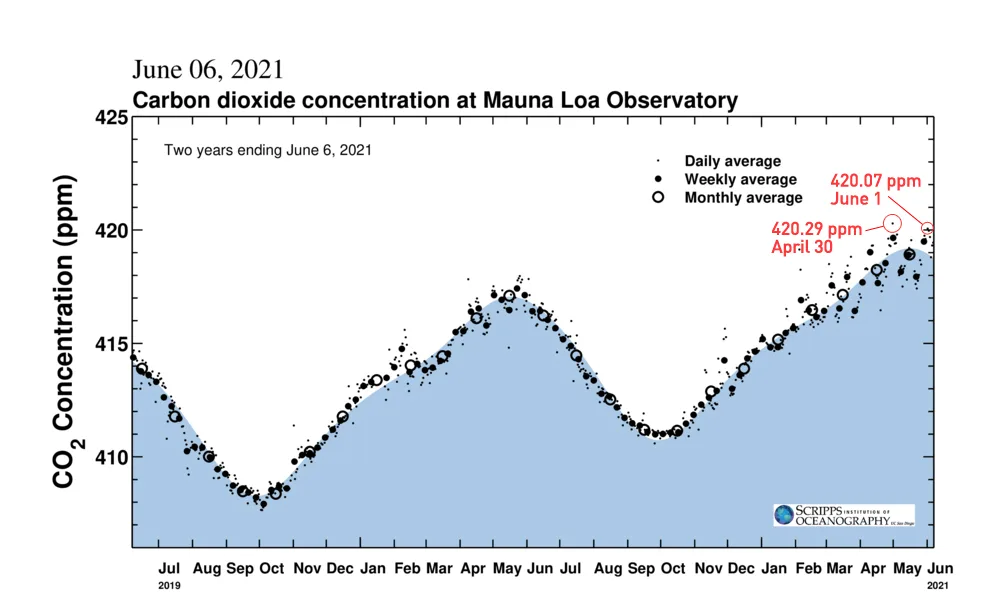
This two-year plot of carbon dioxide measured at Mauna Loa shows the yearly 'saw tooth' pattern that carbon dioxide levels follow due to seasonal changes. In 2019, CO₂ peaked at 415 ppm and in 2020, daily averages reached 418 ppm. In 2021 so far, 420.29 ppm is the new daily record, set on April 30, with another 420.07 ppm measurement logged on June 1. Credit: Scripps Institution for Oceanography/Scott Sutherland
A total of 420 molecules of carbon dioxide for every million air molecules may not seem like much. However, Earth's climate is extremely sensitive to the amount of carbon dioxide in the atmosphere.
WHY IS CARBON DIOXIDE SO IMPORTANT?
Carbon dioxide is considered to be the 'global climate thermostat' for planet Earth. That means the abundance of this one gas in the Earth's atmosphere is the primary controller of the planet's surface temperature and thus its climate.
Most of Earth's atmosphere — the 99.9 per cent made up of oxygen, nitrogen, and argon — absorbs neither incoming solar radiation nor the infrared radiation emitted by Earth's surface. So, if these were the only gases in the atmosphere, the heat radiating away from Earth's surface would escape into space just as quickly as solar radiation was absorbed. This would make Earth a substantially colder place; perhaps up to 30°C colder, overall.
Carbon dioxide, on the other hand, allows incoming sunlight to pass by unaffected, but it absorbs the heat radiating from the ground. With just a trace amount (around 0.04 per cent) in the atmosphere, enough of that heat is trapped that the planet stays warm enough for life to take hold and for human civilization to flourish. Adding more CO2 to the air, incidentally, causes more heat to be trapped than normal, which is why we are seeing a fairly steady rise in temperatures since the Industrial Revolution.
Watch below: NASA climate scientist Bill Putman explains the yearly waxing and waning of carbon dioxide throughout a year
The other major greenhouse gases that contribute to Earth's surface temperature are water vapour, methane, nitrous oxide, and ozone. None of these control Earth's climate as effectively as CO2, though. There's one straightforward reason for this: Carbon dioxide is the most abundant temperature-independent greenhouse gas in Earth's atmosphere.
Methane, ozone, and nitrous oxide are more potent greenhouse gases than CO2. However, carbon dioxide is far more abundant in the atmosphere than these gases. Thus it still has a more significant contribution to global warming.
Water vapour is a special case. It is not only a more potent greenhouse gas than carbon dioxide, it is also more abundant. However, water vapour's presence in the atmosphere and its contribution as a greenhouse gas are entirely dependent on the temperature. Lower the temperature by a certain amount, and water vapour condenses into liquid water, forming clouds and precipitation. Lower the temperature even further, and it freezes solid.
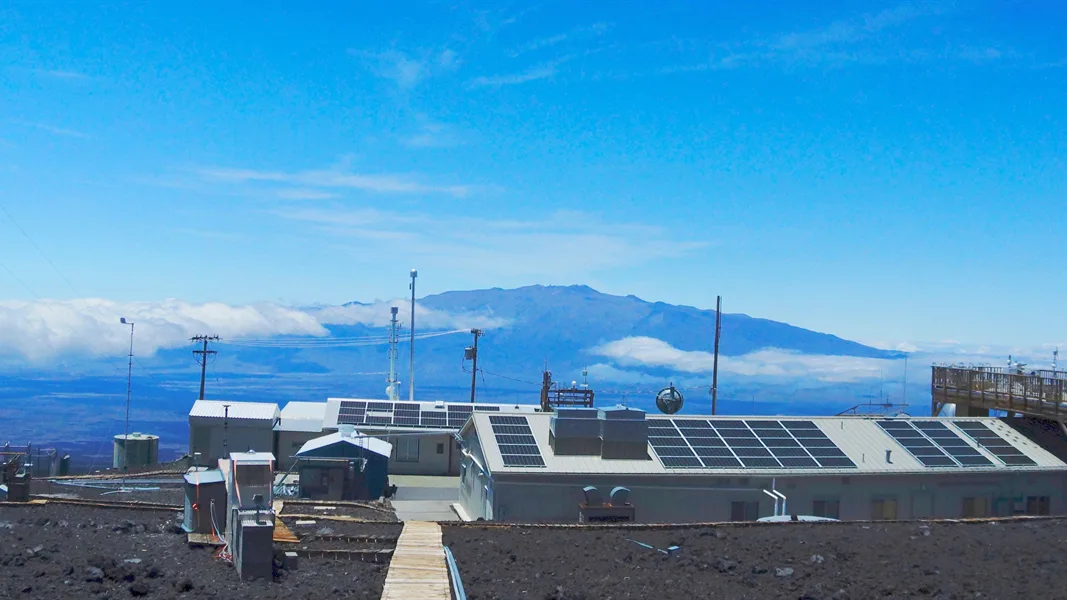
NOAA's Mauna Loa Observatory, high atop the volcano in Hawai'i, is a remote enough location from sources to give us an excellent idea of the carbon dioxide concentrations in the northern hemisphere of Earth. Credit: NOAA
Carbon dioxide, on the other hand, is temperature-independent. No matter how you vary the temperature on the planet, CO2 remains in gaseous form and retains its full potency as a greenhouse gas.
The very reason we have large quantities of water vapour in Earth's atmosphere in the first place is due to the temperature-independence of carbon dioxide. If the amount of CO2 in the air decreases, the planet cools, which causes more water vapour to condense and eventually freeze. This is how most glacial periods in Earth's history started, as CO2 was absorbed from the air by various forms of life and became locked up or buried away in large quantities. When carbon dioxide levels rose again due to extreme volcanic events or mass die-offs, temperatures increased, and the amount of water vapour in the atmosphere also increased.
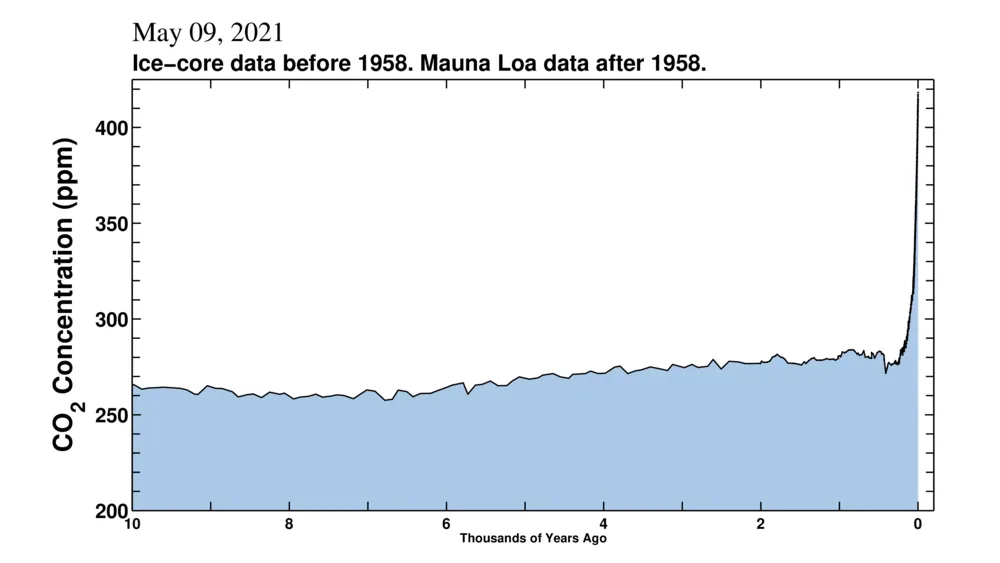
By measuring gases trapped in ice cores, scientists have shown what carbon dioxide levels were like in the atmosphere, going back 10,000 years. Credit: Scripps Institution of Oceanography
In the roughly 10,000 years before the industrial revolution, when CO2 levels were reasonably uniform at around 265 ppm, Earth's climate remained relatively stable. The greenhouse gases in the air absorbed just enough of the heat Earth radiated out towards space to keep the planet's average temperature reasonably steady.
As shown in the graph below, due to carbon dioxide emissions from fossil fuel burning, the global average temperature has risen by roughly 1.5°C since the early 1900s.
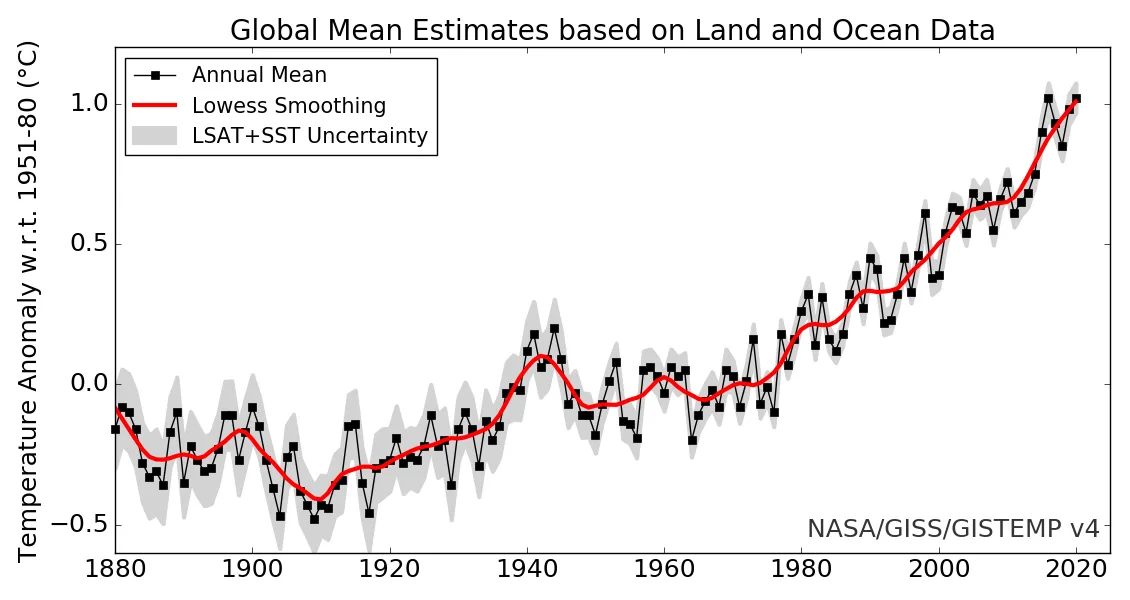
Credit: NASA's Goddard Institute for Space Sciences
Seeing this kind of temperature increase in a small region, over a short period of time, such as in the local forecast for your city over a few days, is not much of a concern. It represents only a small amount of energy, and the temperature will eventually go down by that much, as well.
The entire planet warming up by over one degree, however, and in such a way that the temperature will not go down again by that amount for the foreseeable future, represents an immense amount of energy being invested into our weather and climate systems.
This is of great concern to us when it comes to extreme weather events and their potential impact on human civilization. It is going to be even worse, going forward, as greenhouse gas emissions continue to rise, and the temperature continues to rise along with them.







